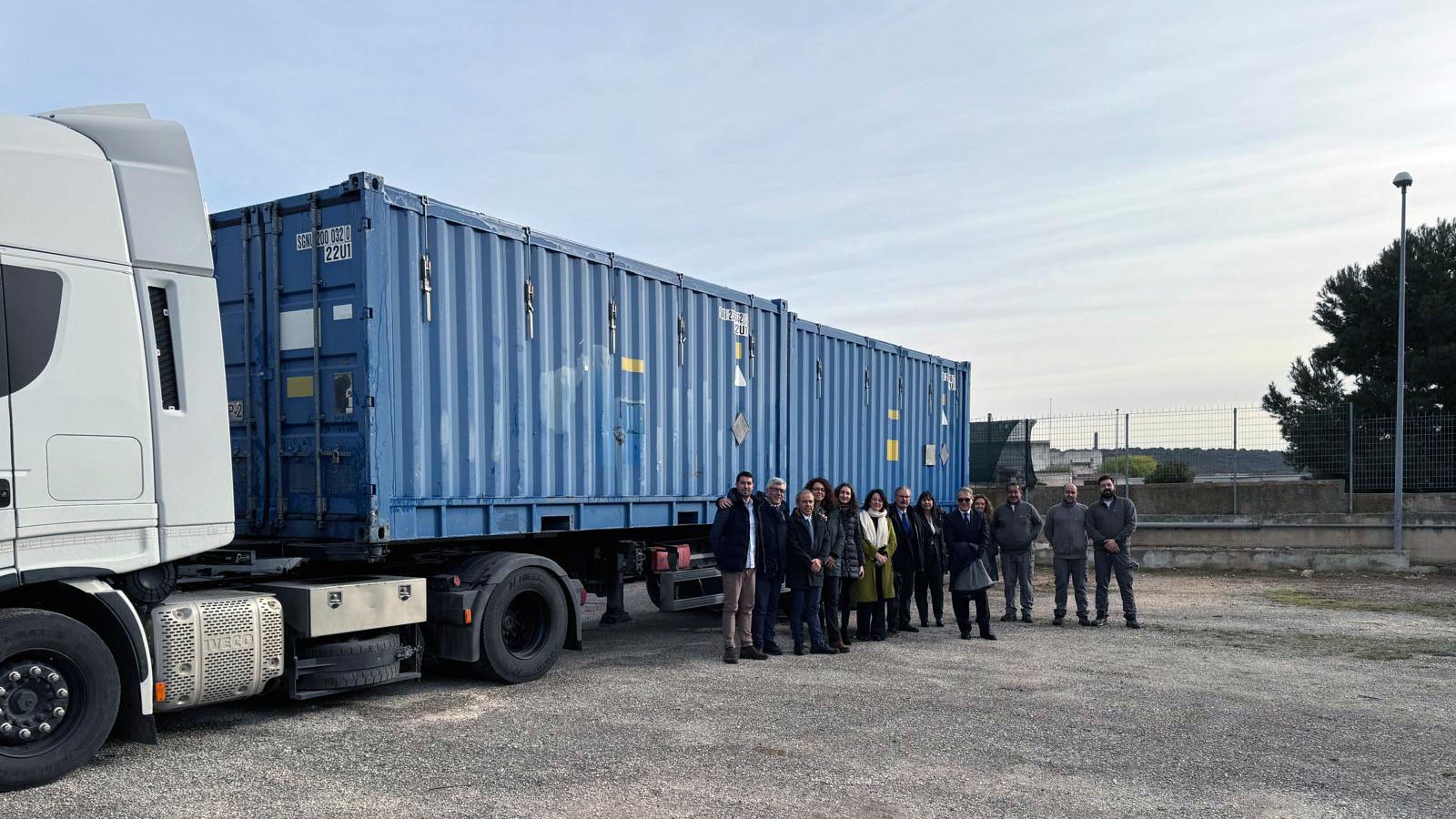Emptying out of the Cemerad repository completed
29 January 2025

This morning saw the final transfer of the last 141 drums of the more than 16,600 containing radioactive waste from the Cemerad repository in Statte (Taranto) to the Nucleco (a company controlled by Sogin) Casaccia facility.
The departure of this last consignment took place in the presence, among others, of: Vannia Gava, Deputy Minister of the Environment and Energy Security, Vera Corbelli, Extraordinary Commissioner for the implementation of the intervention for the safety and management of hazardous and radioactive waste located in the former Cemerad repository, Serena Triggiani, Puglia Region Environment Advisor, Fabio Spada, Mayor of Statte, Francesco Campanella, Director of the National Inspectorate for Nuclear Safety and Radioprotection (ISIN), Mario Lazzeri, Executive Assistant to the CEO of Sogin, Nadia Cherubini, President of Nucleco and representatives of the various State Entities and Bodies involved in the operations.

Finalising this operation provides us with a solution for one of the country's greatest environmental criticalities. In total, 16,640 drums were removed containing sources, filters contaminated by the Chernobyl event, radioactive waste produced by medical, industrial and research activities, which were within a dilapidated structure, collected by the Cemerad company between the mid-1980s and 2000, when the site was placed under judicial seizure by the Taranto Public Prosecutor's Office.
In 2017, based on a legal provision, the Extraordinary Commissioner had directly entrusted Sogin, a State Company that made operational use of its subsidiary Nucleco, with safely managing the emptying and remediation of the Cemerad repository. The removal of the drums from the site began on 15 May of the same year. Transportation was interrupted due to lack of funds in October 2020, and then resumed in October 2023, thanks to the Extraordinary Commissioner who managed to secure the necessary funds to complete the operations.
The work was made particularly complex due to the deterioration of many packages found inside. This then needed 92 trips to move the drums away, breaking down operations into three phases to optimise and speed up activities. During the first phase, each drum was identified and catalogued according to its radiological characteristics for transportation and subsequent treatment. The second phase involved evaluating the physical integrity of the drums, which often needed "repackaging" to avoid spills. In the third phase, after the transport documents had been prepared, the drums were transferred to the facilities of authorised and specialised operators.
The treated and secured radioactive waste will now be stored in Nucleco's temporary repositories pending its final transfer to the National Repository, once this becomes available.
The total value of all activities, which will be completed by the end of the current year with the remediation of the site free of radiological constraints ready to be reused for other purposes, is approximately 18.8 million euro .
“
"The ultimate objective of the activity that the Commissioner has carried out over all these years is the radiological reclamation of the site and release of areas free of radiological constraints – said Vera Corbelli, Extraordinary Commissioner for the reclamation of the former Cemerad di Statte site – This complex and articulated operation is unparalleled in Italy from the perspective of the state of abandonment and degradation that the repository was in, the very high number of accumulated drums, their state of deterioration, the unclear information we had about the content of the drums. After resolving a number of technical, operational, administrative and management problems, which were also overcome thanks to the support of the Presidency of the Council of Ministers and the Ministry of the Environment, the last load leaves today. The seal puts an end to a long history of environmental degradation and abandonment, a history that could have become dramatic as well as dangerous, because this place contained unprotected radioactive materials that could potentially have become weapons in the hands of unscrupulous individuals. The intervention was characterised by innovative aspects related to Governance, involving close synergy with the National Inspectorate for Nuclear Safety and Radiation Protection and the direct involvement of Sogin, a State company specializing in the sector, and its subsidiary Nucleco. It is important to emphasize that the management of radioactive waste was undertaken with the exclusive involvement of State entities or State Companies.
It was not easy to achieve this extraordinary result because in addition to the difficulty of having to write a new piece of history on environmental remediation, a new and unprecedented story, we also had to "fight" against numerous unforeseen events, finding new administrative and management solutions. It was a challenge that had a profound impact on us, but together with the Management Coordinator, Dr. Capasso, the Operations Manager, Mr. Velardo, and the entire work group, we are proud to have completed the project successfully. We are proud to return a piece of the now healthy territory to Taranto, and we sincerely hope that the work of care and environmental protection of the vast Taranto area, and its restitution will continue for all the institutions involved".
“"Emptying the Cemerad repository of more than 16,000 drums of radioactive waste that had been abandoned for twenty years – said Gian Luca Artizzu, CEO of Sogin - was a job that required specific management and operational expertise. We are therefore particularly satisfied with the success of this work – Artizzu added -which represents a decisive step towards the environmental remediation of the area, and which confirms the value of our skills ranging from the nuclear sector to the recovery and enhancement of industrial sites and infrastructure".